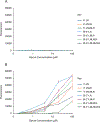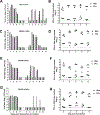Transmission of a human isolate of clade 2.3.4.4b A(H5N1) virus in ferrets
- PMID: 39467572
- PMCID: PMC12004158
- DOI: 10.1038/s41586-024-08246-7
Transmission of a human isolate of clade 2.3.4.4b A(H5N1) virus in ferrets
Abstract
Since 2020, there has been unprecedented global spread of highly pathogenic avian influenza A(H5N1) in wild bird populations with spillover into a variety of mammalian species and sporadically humans1. In March 2024, clade 2.3.4.4b A(H5N1) virus was first detected in dairy cattle in the USA, with subsequent detection in numerous states2, leading to more than a dozen confirmed human cases3,4. In this study, we used the ferret, a well-characterized animal model that permits concurrent investigation of viral pathogenicity and transmissibility5, in the evaluation of A/Texas/37/2024 (TX/37) A(H5N1) virus isolated from a dairy farm worker in Texas6. Here we show that the virus has a remarkable ability for robust systemic infection in ferrets, leading to high levels of virus shedding and spread to naive contacts. Ferrets inoculated with TX/37 rapidly exhibited a severe and fatal infection, characterized by viraemia and extrapulmonary spread. The virus efficiently transmitted in a direct contact setting and was capable of indirect transmission through fomites. Airborne transmission was corroborated by the detection of infectious virus shed into the air by infected animals, albeit at lower levels compared to those of the highly transmissible human seasonal and swine-origin H1 subtype strains. Our results show that despite maintaining an avian-like receptor-binding specificity, TX/37 exhibits heightened virulence, transmissibility and airborne shedding relative to other clade 2.3.4.4b virus isolated before the 2024 cattle outbreaks7, underscoring the need for continued public health vigilance.
© 2024. This is a U.S. Government work and not under copyright protection in the US; foreign copyright protection may apply.
Conflict of interest statement
Competing interests: The authors declare no competing interests.
Figures











References
-
- Nguyen T-Q et al. Emergence and interstate spread of highly pathogenic avian influenza A(H5N1) in dairy cattle. Preprint at bioRxiv 10.1101/2024.05.01.591751 (2024). - DOI
-
- Avian Influenza (Bird Flu) (Centers for Disease Control and Prevention, accessed 7 November 2024); https://www.cdc.gov/bird-flu/situation-summary/index.html.
MeSH terms
Substances
Grants and funding
LinkOut - more resources
Full Text Sources
Medical

